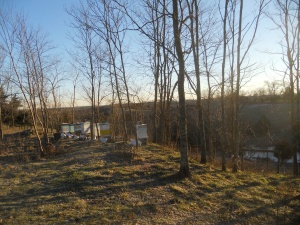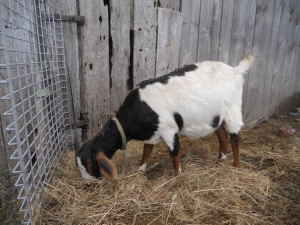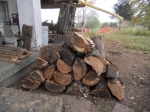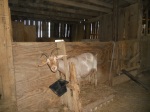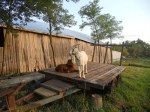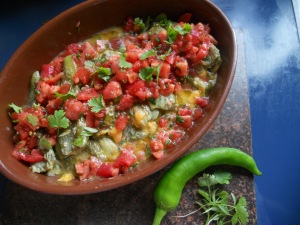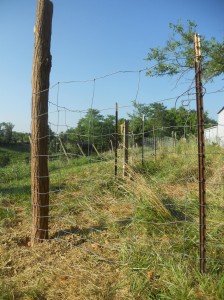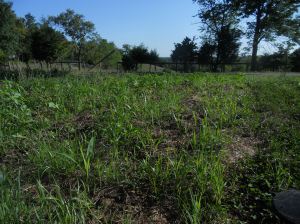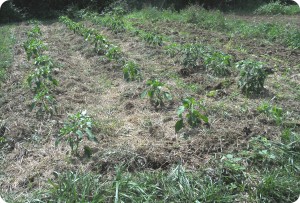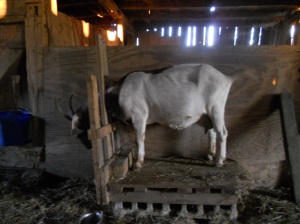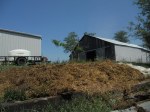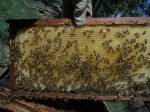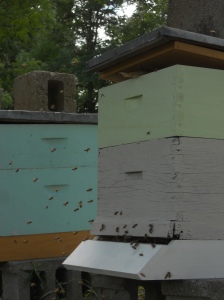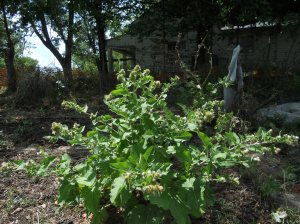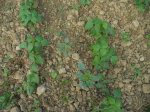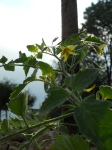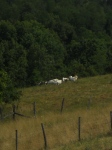You are currently browsing the category archive for the ‘Seasonal Reflections’ category.
Gloves (2 layers). Krocs. Barn coat. Hood, hat. Cowl. Hoodie. Totally dorky snowpants. Sweatshirt.
Gloves first? Yes, I’m back after the third barn trip of the day. We’re warm-blooded crustaceans out here. Cold is a predator, and overlapping garments are armor. Once encased, I can face anything. Now I’m molting.
Kidding season hasn’t really begun – they bred to kid at the end of January – but it’s off to a poor start. Monday they were calling for single digits. After feeding grain, I filled the hay nets in the stalls and coaxed them in, including low goat Trillium, her daughter sly, agile Zinnia, and Edie, who kidded in August and wasn’t allowed to breed again this season. Either the boss goats had been chasing them outside at night, or they had just been keeping themselves away from the charging and butting. But this night, every bit of warmth and muscle mass would count. Once they were shut in, I let go of worrying and concentrated on keeping the house snug for the night.
At 7:3o AM Tuesday, the kettle of hot water from the woodstove went into a water bucket along with a cup each of corn oil and dark molasses – tonic to prevent ketosis of pregnancy. My cardio for the month has consisted of lugging this to the barn and doling out portions to each doe while the others jostle her for more than their fair share. This gives me the chance to count them – well, call their names from eldest down – and in doing this I missed Lilly, and heard her, still in the back stall, bleating.
There she stood, the sturdy 2-year-old, nuzzling at 3 limp shapes in the trampled straw: two half frozen, one just cold. She had done her best to lick them dry, and they were well-developed, but skinny, most likely premature. Either they were born dead, or died a few minutes from hitting the cold air: apparently none of the three ever drew breath.
What could I have done? Well, if I had even considered the possibility that she would go into labor ten days before her due date…OR happened to check the barn at midnite and seen her pawing the litter – OR… gone to the barn at 6, or 5, or 4…
Most likely there was nothing I could have done. What would I have tried? What I’ll try now: have a laundry basket of dry towels by the door: keep a pan of warm water on to thaw a jar of frozen colostrum: set the alarm for every four hours, sleep in work clothes, get up, pull on snowpants, slip on cowl, hoodie, hat, hood, barn coat, Krocs and gloves, and take the tiniest flashlight I own, to keep from startling or waking them. Walk out in air that feels at first breath like a cool drink, and later like inhaling sand, step inside the barn door and stand listening – for pawing, grunts, restlessness (a doe in labor will get up, lie down, get up, lie down…) or worse, a shrill but thready bleat. Or two, or three.
It’s been quiet in the darkness, the last three nights, and early mornings: just the soft steady crunch of cud. So I quickly run the light across the sleeping shapes: one or two blink at me, nicker softly and settle their chin on their mother’s or sister’s or daughter’s back. (My flock now are all related in some way to each another. I should make a chart. ) Relief… short brisk walk…molt armor… bed.
Every year, a new concern, a new response. Last year, too-rich feed led to triplets and even quads. How to tube and feed a cold kid. This year, premature labor, which could happen to any of them, but didn’t have to happen on the worst of the cold nights. And the decision: no more September breeding: no more pushing to have meat processed by April: no more putting them, or me, through this. Friendly, motherly Lilly, her mother, aunts, sisters, will be resting till October.
…. comes in several forms: 1, a huge oak limb crashes onto the tractor road – volunteer fuel…
- 2. On a damp, chilly morning there’s warmup work to do.
- 3. Section of ancient Black Walnut fence post, a tribute to another’s hard work
- 4. Trimmed ends of fence board split into good kindling
- 5. Colorful surprise: velvety mauve lichen I’ll have to look up.
- 6. Getting oak logs down to size, I’m warm already.
- 7. Now indoors to check the stove: plenty of coals for a good blaze
- 8. Then the overcast from Storm Sandy allows us a grudging sunset
9. and last, warm gratitude (from one who can’t start a chainsaw) for all who helped it to happen. Steve. James. Jess.
My first Fall hive check: 3 hours’ work these images barely sum up. And we’re not done: there are acres of asters still budding out, and they’ll gather while the temperature permits them to be active.
- With a kind and patient mentor…
- …and a sheltered site with the hill (NW wind) at their backs…
- …and a loooong wildflower season, I make the scary venture into…. Beekeeping!
- My “Beewatch” bench, also staging area for hive work: and we have ignition!
- A quick peek in the brood box of my new hive…
- … finds a full, active population….
- … shows frames full of sealed brood, with capped honey in the corners…
- …. and one deep frame still filling with White Aster honey.
- Extra frames from supers go in the new hives to help out…. They also get…
- …feeder rims for Winter supplements to honey stores…
- …moisture quilts to absorb condensation, conserve warmth and improve ventilation…
- … light inner cover, high-tech prop (a stick) while the days remain warm and they can still forage…
- …then a solid metal lid and weight. Done!
Some things I have learned, besides the obvious “How to Look After Bees” points:
– don’t “just stop to peek at the hives” in red check barn coat. Bees see red as black, and me as “bear!” Left eye swollen shut x 4 days.
– Really not allergic to bee stings, parents just over-reacted. Nice to learn after 50 years, glad I didn’t let it stop me.
– Smoker works on “campfire principle” – gets burning real good just when you close up the last hive/run out of marshmallows.
– Garden yields the last ten years had clearly suffered more from decline in pollinators, than I had any idea. The difference this year for squash, beans, chiles and tomatillos is four-fold.
– Walking the woods and fields has taken on a more personal dimension. Now every tiny golden blur in a patch of clover, a locust tree, a blackberry cane or a clump of asters and goldenrod, might be “one of my bees.”
My posts have been kinda veggie (or even buggy) lately, so here’s some Goat Appreciation. … at a sad time for a number of reasons. I will miss milking, especially calm, biddable Trillium. But it’s breeding season, time to plan for next year’s kids. And I will miss the milk, especially on Frosted Flakes (my secret weakness). But on chilly mornings lately, I have walked to the barn thinking No, I don’t want to keep doing this thru Winter. I will miss pounds of creamy soft chevre every week, and friends and family will too. But this Summer I never did get to make Romano (the mold I needed didn’t arrive) or Mozzarella (the friend who was going to show me didn’t either).
And out at the barn or pasture, among the flock, there is always change:
- No more morning treats?
- Lily’s fine twins have gone to processing – “Rock”…
- …and brother “Choc,” shown with cousin Zinnia awaiting her first offspring
- Edie’s August twins, promising does, have a new home waiting early next year
- Columbine, Aggie and Jonquil, just hoping for healthy, lively kids in early ’13.
- Spock, proven fertile, sweetest and least aggressive buck goat of any I’ve known, has at least one more season with us.
To everyone this year who shared in milk, cheese, cajeta, milking or taking care of goats, and those who gathered for and helped with August’s Goat Roast, thank you very much and I hope you enjoyed it all as I did.
Goat Roast weather was hot and dry. The day after, it seems as if your friendship and fellowship brought one last blessing.
My Chicana landlady during grad school shared this simple, uniquely flavorful dish, with ingredients that were hard to find in 1970, but today come from my own garden. For the recipe, the knowledge and the table laden with comida casera – ¡Muchas Gracias, Tia Yvonne!
12 Anaheim chiles, roasted, seeded, peeled, etc.
6 oz jack or colby cheese, sliced into 12 pieces, 3” by ½” by ¼”
1 egg beaten with 1 tbsp water, ¼ tsp salt until very fluffy
oil or cooking spray
2 large very ripe red tomatoes, peeled and diced
1 medium onion, slivered, or large bunch chopped chives
1 or 3 serrano chiles, diced very fine – optional
½ cup chopped cilantro
2 oz grated cheese
Slip the slices of cheese inside the chiles carefully. Heat a tbsp of oil in a saute’ pan, or coat heavily with cooking spray. Roll a stuffed chile in the beaten egg and place in skillet: repeat with two more. Now turn the first (the underside should be lightly browned and a bit crisp), repeat with second and third. Now remove the first to an ovenproof dish when both sides are browned and crisp, and follow with the others. Repeat with remaining chiles, three at a time.
When all the chiles are fried, combine the tomato, onion, serranos and cilantro, and pour over the stuffed fried chiles in the baking dish. Place in 325 oven for about 15 minutes – it doesn’t take long, you just want the flavors to blend. Top with grated cheese, return to oven just long enough to melt cheese. Serve with flour tortillas.
Bear with me, there’s some history here.
Last Winter my does had four sets of triplets, one of quadruplets and three of twins. A fine crop, but not without losses.
The saddest was Edie #27, who lost all three: one, a huge buck, was born dead and the other two were compromised by delayed labor. Thin and subdued, she’s still been a devoted aunt to Aggie’s three. On Genia’s advice, this year I am feeding less grain, which should (has, so far) reduce both multiples and birth size.
In March, a cheering visit from my newest apprentice goatherd, Alaina.
Including some practice in rounding up young Spock, who had successfully challenged his pen and, out among the flock, was showing interest in poor bereaved Edie. Who was, surprisingly, showing interest in him.
He hasn’t been out again since Steve’s last job of reinforcement. And “poor Edie” regained appetite, weight and spirits. Well, yeah…
Then around August 1, she started filling her udder. And the timing (150 +/- days) was just about right.
Last evening, Jess put in a wearying hour helping get her into a kidding stall, with an alarmingly distended udder. At 6 AM, there were 2012’s newest lives, two lively, but quiet girls, like their sweet mother.
After my last post, I hope the point(s) are clear: rewards, sometimes unplanned for, if not totally unexpected: and support, help and friendship.
It’s usually not till Time Change in October, that I start going on about day length and its effect on our spirits. But August is none too soon.
The Earth is not a perfect sphere, being slightly flattened in the Northern Hemisphere. This gives us two lovely months from June to August when the days dwindle only a second or two at a time. But that also means a sudden shift in early August, as our view of the Sun’s path reaches the southern limit of that flattened segment. Tomorrow will drop by 2 minutes and ten seconds. We will miss them.
It’s not just the amount of light to get things done, it’s mood and judgment. Assume, safely, that it’s not a time to start risky projects or make big plans. But (Public Service Announcement from Friendly Know-It All), neither is it the time to give way to doubt, misgivings and discouragement.
Just as when we wake in the middle of the night, everything seems gloomier than in the day, the same way in late Summer, our lower serotonin levels can trigger apathy, futility or even resentment of our daily burdens.
Garden disappointments accumulate: it’s easy to say “Let the weeds take it.
Oddly enough, or maybe not, this strenuous but spare way of life provides several trusty antidotes. Physical work itself is said to combat depression: or is depression a malady of idleness? If we remain obligated to the land and lives under our care, the issue is moot.
Not focussed on acquisition of stuff, we look forward to an unfailing reward in the constant renewal of living things. As Trillium’s and Jonquil’s milk yield decreases, breeding season is on us, and next year’s babies are in mind.
Ride it out and have faith. The Earth keeps turning and life is constantly revived. Time to milk!
Time to live!
After a few inches of rain and a break in the heat, there’s progress. A wonderful visit with my nieces, a ton of barn work with Jess, and the ever-stimulating company of about 30,000 small workers.
- My great-niece Marie apparently never met an animal she didn’t like – or vice versa!
- The two youngest buck kids are sizing up.
- Tilled rows for the second planting of Summer Squash
- Blooms are thick on the Black Beans
- Jess’s three days’ work…
- …in the heat, goats enjoy a cool cleared stall…
- …and the new Squash ground gets fertilized
- A good hive check: the first medium comb,starting to fill with honey…
- …the last deep comb drawn, filled with honey and starting to be capped…
- ….newly laid eggs visible in cells!
Today, after morning chores, greenhouse work and spreading mulch for the chiles, I ducked over to the hives. The other 7 had the normal coming & going, but mine was at the center of a cloud of very very busy bees. On my last detailed check, there were at least two solid frames of sealed worker brood, a good sign. The timing today would be about right for them to have matured into foragers. But what was all the excitement?
- The punishing hot/dry spell severely set back their mainstay Ladino clover. Recent rains have greened it out, but there’s not much new bloom yet. In the Big Hayfield, Silky Lespedeza, an introduced forage crop, is just beginning to set buds. I wondered if it was the Buckwheat, summer fallow in one of the big garden plots.
On the way back from checking the Buckwheat, I stopped to get a pic of one quirky weed control strategy. Burdock- Family, Compositae: Life cycle (an odd modifier) “Monocarpic perennial”- Greek mono, one… carp, fruit – is a perennial that lives several years, but blooms (and seeds) only once, then dies. (Don’t ask “What good is a liberal education?”) If you leave it for 3 or 4 years, Burdock’s large basal rosette produces a seed stalk, then dies. It then takes very little effort to get it pulled, and burned.
A good overall philosophy of weed management, Know Thy Weed: it beats blasting everything with Roundup, and there was an unexpected payoff. As of today, I know Burdock a little better than before.
The hillside that I am, er, managing by letting it flower and die, has a cloud of honey bees coming and going. There’s still a bunch of scratchy, irritating stalks to uproot come Fall, but for now some tireless young foragers have their reward.
Oh, the rain also helped the Summer Squash, without which the bees (and their caregivers) would be much worse off.
- A female squash blossom supplies 3 different insect species!
I’ll just let the pictures tell the tale.
- Cumulus mammatus, “Breasts of the Rain Goddess,” promise rain… but…
- …but… by night the clouds have divided and passed us by
- Leaves burnt by the heat, the squash still produce
- Cannellini beans sprouting and growing without a drop of rain
- Black beans manage with help from soaker hose
- Tomatoes bloom, but will they be pollinated?
- Most of the Squash blossoms now are saved for the bees
- The best time for browsing – evening cool
- Another Sun sets under high pressure
There’s not a lot to say anyway, except that we (see above) are surviving.


